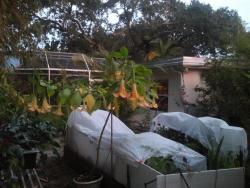
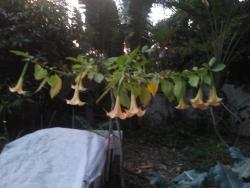
RickCorey said:>> 5.what is best to preserve zinnia seeds.....paper bags or sandwich nylon degradable bags
As long as the seeds stay DRY, either one can work.
Also, if you are only storing seeds for one year, or maybe two years, and you don;t mind if their viability (% germination) goes down from 90% to 50%, almost any kind of storage that's reasonably dry and cool and non-varying will work out OK.
However, suppose you want to keep some seeds with high viability for 3, 4, 5 or more years.
If the air where you store them varies in humidity, or is ever much above 40% RH, , paper will let the humidity changes go right through and affect the seeds. That's very bad. If you want to store seeds for more than 1-2 years, they need stability and cool dryness.
Swings in humidity or temperature shorten the storage lifetime of seeds.
So plastic might be better in that case (if the seeds are very dry when you seal them away).
However:thank you for a long and informative answer......by the way the compost heap is very soggy ...i am less worried because of the teribly hot weather .but i think i will start a new one and let this one rest
If you put seeds into plastic and seal it before the seeds are dry, Dry, DRY, more humidity will keep coming out of the seeds. Air inside the plastic Zip-Loc will become more humid than 50% RH. Rot will start soon after that.
OK, dry the seeds below 50% RH before sealing them in plastic or glass. That slows down their metabolism so LESS humidity is released over time.
But remember that humidity KEEPS coming out of seeds, because they are metabolizing slowly. And they metabolize faster if their humidity is (say) 40-50% instead of 15% to 20%.
So dry those seeds below 20% RH before sealing them tight!
Fortunately, plastic does let humidity leak slowly right THROUGH thin plastic film. And those cheap "zippers" on Zip-Loc bags are NOT any kind of hermetic seal.
So even if you seal up some seeds that are only 30-40% RH dry, the extra humidity will keep coming OUT of the baggie IF you keep the air around the baggie really dry - like 20% or 15% RH.
Now we're talking about a desiccant, or living in a desert with constantly-low-humidity.
The desiccant and seeds have to be sealed together in some tight jar, or else the desiccant will try to pull the humidity out of the air in your house, yard and county ... until it uses up its capacity for water and is exhausted.
If you seal seeds and some desiccant into a jar, it doesn't matter whether you packed the seeds in paper or plastic. The very-dry-air in the jar will slowly pull excess humidity out THROUGH a plastic Zip-Loc baggie.
It will rapidly JERK excess humidity out of a paper envelope full of seeds, so don't seal seeds with desiccant until they are finished ripening and drying slowly on the vine.
http://garden.org/ideas/view/R...
http://garden.org/ideas/view/R...
I was trying to write an article about desiccants in general, but didn't have enough good photos, and then I left it unfinished as a blog entry
http://garden.org/blogs/view/R...
The short form is: get silica gel from a craft store that sells flower-drying supplies. Make small paper packets with a tablespoon of silica gel. For example, use a paper coin envelope.
Kew Royal Botanic Gardens Technical Information Sheets
http://www.kew.org/sites/defau...
"Seed life span approximately doubles for every 10% reduction in seed eRH."
Many other Kew Tech Info Sheets about seed collection and storage:
http://www.kew.org/science-con...
dyzzypyxxy said:On the question of supplying plants for your bank, to grow indoors, let me just say it's going to be a big headache for you, David.
If they cool it excessively in the summer, and heat it too much in winter, then the air is just generally going to be very, very dry. Something like a succulent - Sanseveria comes to mind - is the best bet for a plant that might stay good looking for more than a few weeks in that environment. But, also every plant needs good light to keep healthy and growing. Do they have big windows or skylights at the bank?
About "late blooming" flowering plants: usually perennials like celosia and chrysanthemums come to mind. They fill in the late summer, into fall with some nice flowers, then generally die back almost to the ground, stay dormant through winter and jump right back up in spring, making an ever-larger clump. They're great value in flowering plants.
There are a few flowering plants that will go though winter, still putting up some flowers. Pansies come to mind, but they will fade out and possibly die in the hot, dry summer weather where you are.
Most people start seeds of perennials in the fall, for earlier bloom in the spring. But if you want to keep seedlings going through winter it takes special care, the right amount of watering, and protection from frost. This can be supplied easily if you don't have too many cold nights. Something as simple as a cardboard box put over the plants for the night will usually keep them from frost damage. Here, I drape my tender plants with special 'frost cloth' that breathes a bit, but traps enough heat rising from the ground to keep the temperature at least 10deg. F warmer than the outside air.

I usually remove it for the daytime to let the plants get maximum sun benefits, but probably have to cover everything about 5 nights per winter. We also have good humidity here most of the year, which also helps moderate the cold damage to plants.
davidsevit said:1.i still cant understand the"late blooming plants" if a celosia is flowering now.....what does it mean it will keep on until autumn?
if i sow a celosia now....i presume it will survive the autumn cold....why is it called late blooming?
2.i am considering offering our bank to put plants there....inside.today outside it was 35 degrees...inside i froze(point a) in the winter they heat the place unbearably hot and dry(point b)
wich plant would like this crazy situation?
i am not talking about windowsills wich are a more normal task
3.what is the benefit of sowing plants for spring if it is so far a way(in september)
4i want to make home made planters from metal olive tins 10 litre each for spring bulbs.i am aware of the long term problem of rust....i am concerned with the weather problem cold winter....metal.....the principle is that when the blooming is more or less over i take all of the tins and put them in a corner downstairs untill the process is over(short term use) maybe i will poch holes in the sides for summer use after i have taken out the bulbs for storage
5.what is best to preserve zinnia seeds.....paper bags or sandwich nylon degradable bags
stone said:
Some good answers already, but some unanswered questions yet...
Celosia... Amaranth sp?
May bloom now, and spend the rest of the growing period setting viable seed... And depending on the rainfall.... May rebloom.
As a hot weather annual, I wouldn't expect the plants to continue growing after the temps drop near frost.
Regarding "bank"...
Do you mean next to street?
Or where you save your $?
Regarding sowing indoors...
Strictly something we do for especial long season plants that we want to get a jump on the season with.
Like tomatoes and eggplant.
Although... My season is long enough that I sow my tomato seed outside after danger of frost... And the tomatoes produce... And there will still be growing season left after they've pretty much played out.
Starting indoors is for people with short seasons...i have still alot to learn about preparing for winter....here there is a common site in banks$ 40\40\120 centimeters containers with hydroponic plants in them.....they always look pathetic.think of the temperture of the water inside a container at night when people have left the bank.in winter....start-up-an under container heater to preserve normal warmth.how about like in aquariums a small device to heat the water?
35 degrees F? Or C?
You froze... Around here.. I've got to put on a winter coat every time I go indoors... Everybody is running those air conditioners, and my body is adapted to the triple digit heat (Fahrenheit)...
People start seeds indoors when spring is like 6 weeks away... So... You wouldn't want to start seeds in the autumn.

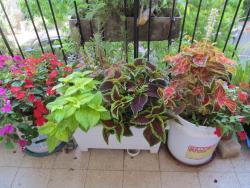
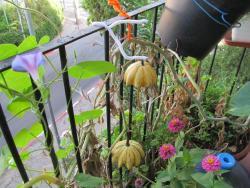
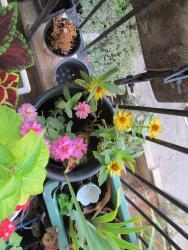
dyzzypyxxy said:On your plants in the shallow planter, well big plants that need lots of water and nutrition might make it to maturity in there, but you are in for a lot of work to keep them going. They just can't grow a big enough root system to feed all the growth that the sun and warm weather are stimulating. So . . . the answer is "maybe".
Your Coleus look amazing! Yes, you will be able to keep cuttings going on a windowsill indoors through the winter, I would think. I have cuttings of Coleus that have grown and flowered in a glass of water. Personally, I'd forget the idea of collecting seeds and just propagate them from cuttings. You can put 5 or 6 cuttings in a small jar of water. Seedlings take a lot of care and attention, too.
Your pumpkins are really pretty. Traditionally, pumpkins get the most sugar into the flesh if you leave them on the vine until the vine dies. But if you are only going to use them for decoration, you can pick them now and get rid of the powdery vines. You're right, that powdery mildew will spread to any other pumpkin, squash, melon or cucumber plant nearby. They are very susceptible. Housekeeping (taking off any leaves that show the fungus) is the best way to keep the other plants clean.
You can also spray a solution of 1/2tsp. baking soda to a liter of water to prevent the spread of that fungus. Many plants aren't receptive to it anyway, but the ones that are, you can make the surface of the leaves not welcome the spores with this solution.